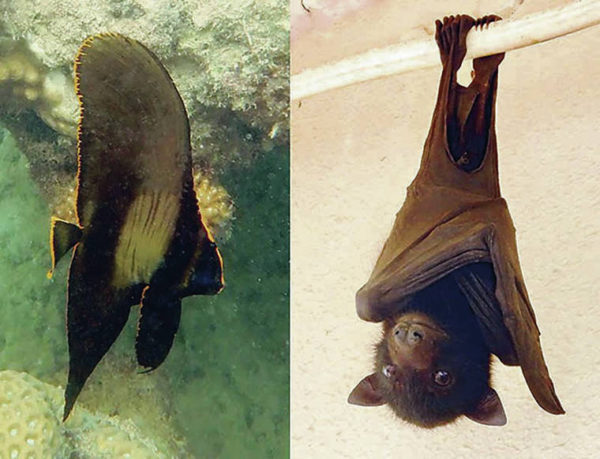Published in the Ocean Watch column, Honolulu Star-Advertiser © Susan Scott
November 9, 2019
Australia’s bats are welcome in my belfry anytime.
A few weeks ago, while getting our sailboat, Honu, ready for sailing the Great Barrier Reef, one of the marina staff told me that an adorable baby fruit bat, also called a flying fox, was hanging on a wire near the fuel dock.
A boater had driven to the marina in his pickup, and when he arrived in the parking lot, he heard the animal cry. Under the truck, the man found the orphaned bat, 6-to- 8 inches long, clinging to a pipe, amazingly unharmed. I sat with the baby until a rescue worker arrived.
 My baby batfish, and Trevor, the baby fruit bat.
My baby batfish, and Trevor, the baby fruit bat.
©2019 Susan Scott
The youngster was a black flying fox, one of four fruit bat species native to Australia. Fruit bats are natural pollinators and seed dispersers of native trees, but in their foraging, they sometimes find and damage fruit orchards. Some growers, therefore, consider the flying mammals pests.
Australian fruit bat numbers have decreased dramatically over the last several decades due to habitat destruction, uncontrolled killing in orchards and climate change altering ripening seasons. All fruit bats are now protected throughout the country with government and private recovery teams at work to help both farmers and flying foxes.
Like a lost puppy, the tiny bat welcomed helping human hands, calmly allowing the woman from a rescue organization to uncurl its feet from the wire, wrap it in a fleece blanket and drive it to its wildlife caregivers.
A week later, while snorkeling in protected waters of the Great Barrier Reef Marine Park, I found another baby bat. A baby batfish that is, sheltered deep in the arms of a branched coral.
Batfish, also called spadefish, are one of those fish families that, as juveniles, differ so dramatically from their adult form in shape, color and behavior, that you can’t believe the little ones are even fish.
Years ago when I had Honu in Palmyra Atoll, my friend said, “There’s a baby batfish on your boarding ladder.”
“That’s a leaf,” I said.
But my friend was right. The foliage I saw on the rung was indeed a fish, pretending to be a leaf. Some juvenile batfish swim on their sides in a rippling motion, mimicking toxic flatworms.
Adult batfish look like big swimming pancakes, up to 20 inches long, their fins and body colors varying among the eight species native to tropical waters of the Indo-Pacific. Hawaii hosts no batfish, and even here in the central area of the GBR, they’re fairly rare.
My investigative dive startled the baby batfish, giving me a moment to snap a picture before it dashed beneath another coral head.
Back at the marina, I learned that our little fruit bat, named Trevor, was doing well in his foster home. Check out Trevor drinking milk from his bottle on this Facebook post: 808ne.ws/Trevorthebat.
After weaning, rescuers will release the youngster in a local fruit bat colony, called a camp.
Going batty in Australia was great fun. As always, however, I’m happy to be home in Hawaii.